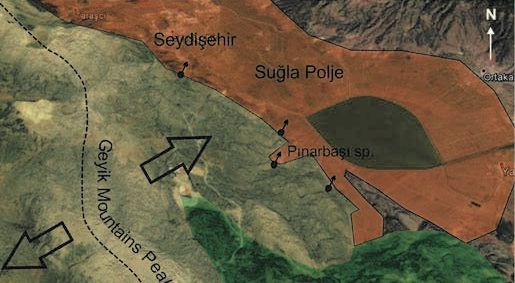Conduit and fracture flow characteristics of Pınarbaşı spring, Central Taurus Region, Seydişehir, Turkey
DOI:
https://doi.org/10.3986/ac.vi.6997Keywords:
Pınarbaşı spring, Recession analysis, Time series analysis, Snowmelt, Mountainous karst, Seydişehir, TurkeyAbstract
This study was conducted to investigate the flow and storage mechanisms of a karst aquifer located at the central Taurus Mountains, Turkey. As the biggest discharge point of the aquifer system, the flow characteristics are investigated at Pinarbaşi spring by using recession and time-series analyses. Continuous water level measurements are taken from the spring and are converted to flow rate by using a rating curve. The spring flows for 7 months (December 2014 – July 2015) and dries up for the rest of the year. Six individual recession periods are investigated and analyzed in the discharge time series. The recession coefficients (between 0.029 day-1 and 0.695 day-1) show that the flow within the aquifer system is mainly controlled by large open conduit and partly fracture porosity. The peak discharge is measured as 7.08 m3/s, and the maximum storage within the aquifer is calculated as 3.15 million m3. The continuous discharge data of the spring were evaluated combined with daily rainfall, temperature, electrical conductivity, and amount of suspended sediment in the water. Also a dye-tracing test was also applied to obtain the recharge-discharge relationship and porosity type of the aquifer system. Statistical tests on discharge hydrograph and tracer test showed that the memory of the karst aquifer was found to be about 3 days in the DJF period and about 15 days in the MAM period. The average elevation of the recharge area of the spring was determined to be 1,490 m by using stable isotope data of snow samples and was validated by dye tracer test made via the swallow hole in the recharge area. The total discharge for the year 2015 is estimated at 16.2 million m3 that approximately 25% of the total discharge is caused by snowmelt.
Downloads

Downloads
Published
How to Cite
Issue
Section
License

This work is licensed under a Creative Commons Attribution-NonCommercial-NoDerivatives 4.0 International License.
Authors guarantee that the work is their own original creation and does not infringe any statutory or common-law copyright or any proprietary right of any third party. In case of claims by third parties, authors commit their self to defend the interests of the publisher, and shall cover any potential costs.
More in: Submission chapter




